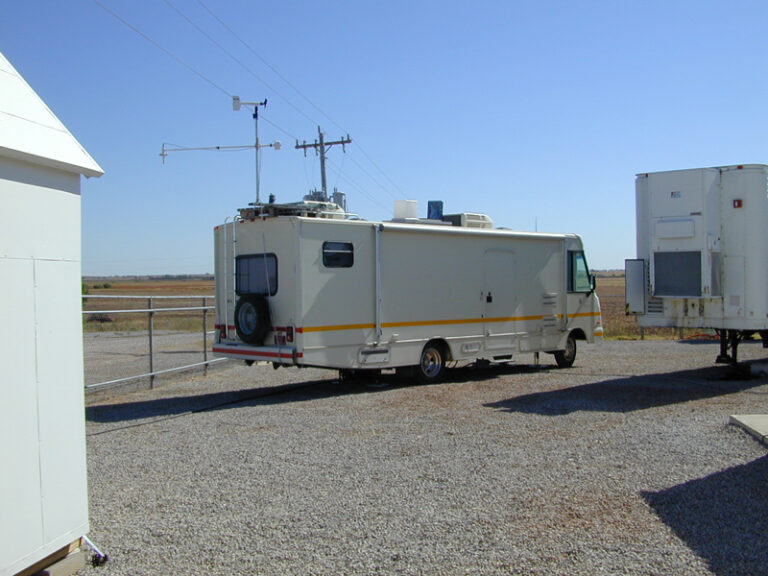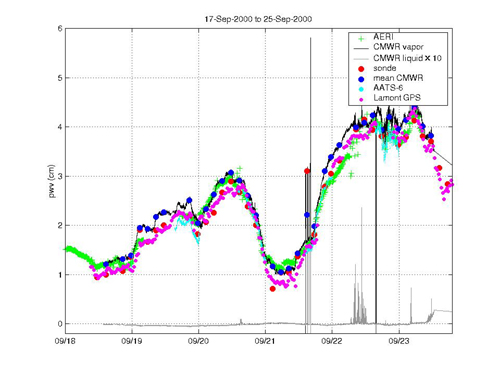WVIOP 2000: Water Vapor Intensive Observation Period (WVIOP 2000)
A series of water vapor intensive observation periods (WVIOPs) were conducted at the Atmospheric Radiation Measurement (ARM) site in Oklahoma between 1996 and 2000. The goals of these WVIOPs are to characterize the accuracy of the operational water vapor observations and to develop techniques to improve the accuracy of these measurements.
Dr. Henry E. Revercomb, Space Science and Engineering Center, University of Wisconsin-Madison
The primary goal of these IOPs is to optimize the capabilities of CART instrumentation for characterizing atmospheric water vapor. While the first IOP concentrated on the lowest kilometer of the atmosphere for satisfying the identified needs of the IRF group, the second IOP will concentrate more on the upper troposphere, as small errors at this altitude has a large effect on the net radiation escaping to space. Also, differences with altitude were seen between two Raman lidars (the CART and NASA/GSFC), as well as radiosonde systematic errors, at these higher altitudes. Another important goal is to address the issue of absolute calibration. There are several independent methods which could be used as the absolute calibration reference, the chilled mirrors, DIAL lidar, and GPS to name a few, and careful intercomparisons of these must be done. A secondary goal of the water vapor IOPs, which meshes well with the primary goals of this IOP, is a careful calibration of both the CART Raman lidar and the NASA GSFC Scanning Raman lidar that is independent of radiosonde calibration. The availability of the NASA Raman lidar is a major asset for these IOPs. Intercomparing the two Raman lidars is an important step in its own right, and the scanning capability of the NASA Raman lidar extends the lowest altitude sensed downward to altitudes sensed by tower-based instruments. Additional wide-ranging intercomparisons of water vapor measurements will also be carried out.
Department of Energy, Atmospheric Radiation Measurement (ARM) Program
Investigators
- Dr. Henry E. Revercomb Space Science and Engineering Center (SSEC)
Related Websites
Publications
-
Revercomb, H. E.; Turner, D. D.; Tobin, D. C.; Knuteson, R. O.; Feltz, W. F.; Barnard, J.; Bosenberg, j.; Clough, S.; Cook, D.; Ferrare, R.; Goldsmith, J.; Gutman, S.; Halthorne, R.; Lesht, B.; Liljegen J.; Linne, H.; Michalsky, J.; Morris, V.; Porch, W.; Richardson, S.; Schmid, B.; Splitt, M.; Van Hove, T.; Westwater, E., and Whiteman, D. The ARM Program’s water vapor intensive observation periods: Overview, initial accomplishments, and future challenges. Bulletin of the American Meteorological Society v.84, no.2, 2003, pp217-236. Reprint #3315.
-
Tobin, D.; Revercomb, H., and Turner, D. An overview of Water Vapor IOP (WVIOP) 2000 and ARM/FIRE Water Vapor EXperiment (AFWEX). Atmospheric Radiation Measurement (ARM) Science Team Meeting, 11th, Atlanta, GA, 19-23 March 2001. Proceedings. Washington, DC, US Department of Energy, Office of Energy Research, Office of Health and Environmental Research, Environmental Sciences Division, 2001, Manuscript not available for publication.
Images
-

SSEC’s Aeribago on site for WVIOP 2000
Cooperative Institute for Meteorological Satellite Studies (CIMSS), University of Wisconsin-Madison -

Weekly Central Facility Total Precipitable Water Time Series: 17-25 September 2000
Cooperative Institute for Meteorological Satellite Studies (CIMSS), University of Wisconsin-Madison
